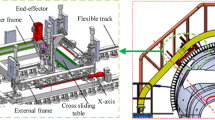Abstract
This article describes a technique for the differential bearings noise reduction. Noise results from the mechanical looseness of the differential gear and connected elements and it is activated by the vibrations of the engine. A test rig for simulation of the phenomenon outside vehicle has been designed and behavior of the differential bearing has been analyzed. Analytical software that is capable to classify the types of the noise has been created. The mathematical model enables estimation of suitable range of differential bearings radial stiffness. Finally, the selected solution is tested on the test rig, thus the technique is verified.
Similar content being viewed by others
References
Adiletta G, Guido AR, Rossi C (1997) Nonlinear dynamics of a rigid unbalanced rotor in journal bearings. Part I: theoretical analysis. Nonlinear Dyn 14:57–87. doi:10.1023/A:1008282014350
Adiletta G, Guido AR, Rossi C (1997) Nonlinear dynamics of a rigid unbalanced rotor in journal bearings. Part II: experimental analysis. Nonlinear Dyn 14:157–189. doi:10.1023/A:1008275231189
Bigret R (2001) Bearing vibrations. In: Braun S (ed) Encyclopedia of vibration. Academic Press, San Diego, pp 152–165. doi:10.1006/rwvb.2001.0092
Byoung-Hoo R, Kyung-Woong K (2003) Acoustical properties of hydrodynamic journal bearings. Tribol Int 36:61–66. doi:10.1016/S0301-679X(02)00132-9
Tanaka M (2000) Journal bearing performance under starved lubrication. Tribol Int 33:259–264. doi:10.1016/S0301-679X(00)00040-2
Takewaki I (2000) An approach to stiffness-damping simultaneous optimization. Comput Methods Appl Mech Eng. doi:10.1016/S0045-7825(99)00321-7
Cimellaro GP (2007) Simultaneous stiffness—damping optimization of structures with respect to acceleration, displacement and base shear. Eng Struct. doi:10.1016/j.engstruct.2007.01.001
Smith WR (1997) Computational results of a dynamic simulation of the conforming shell gas journal bearing. Tribol Int 30:151–162. doi:10.1016/0301-679X(96)00039-4
Sun L, Krodkiewski JM, Cen Y (1998) Self-tuning adaptive control of forced vibration in rotor systems using an active journal bearing. J Sound Vib 213:1–14. doi:10.1006/jsvi.1997.1466
Bouzidane A, Thomas M (2007) An electrorheological hydrostatic journal bearing for controlling rotor vibration. Comput Struct. doi:10.1016/j.compstruc.2007.02.006
Sorge F (2008) Rotor whirl damping by dry friction suspension systems. Meccanica. doi:10.1007/s11012-008-9134-6
Rao SS (2001) Theory of vibration. Energy methods. In: Braun S (ed) Encyclopedia of vibration. Academic Press, San Diego, pp 1308–1324. doi:10.1006/rwvb.2001.0115
Wickert J (2001) Theory of vibration. Equations of motion. In: Braun S (ed) Encyclopedia of vibration. Academic Press, San Diego, pp 1324–1332. doi:10.1006/rwvb.2001.0116
INA (2000) Polygon bearings—reducing resonant vibration in automotive differentials. API 11. Herzogenaurach: INA Wälzlager Schaeffler oHG, 27 p. Sach-Nr 005-349-591/API 11
Author information
Authors and Affiliations
Corresponding author
Rights and permissions
About this article
Cite this article
Mazůrek, I., Klapka, M. & Roupec, J. Radial flexible bearings suitable stiffness estimation. Meccanica 46, 293–302 (2011). https://doi.org/10.1007/s11012-010-9305-0
Received:
Accepted:
Published:
Issue Date:
DOI: https://doi.org/10.1007/s11012-010-9305-0




